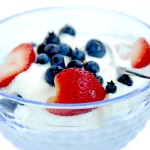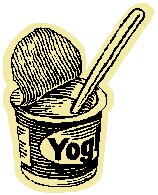|
Yogurt: A Comparison |
||||
|
|
1950 |
2013 |
||
|
|
|
|
||
|
milk fat % |
6% to 10% |
0 % to 3% |
||
|
|
|
|
||
|
bacterial |
present |
present |
||
|
cultures |
|
|
||
|
|
|
|
||
|
milk type |
non-homogenized |
skim milk powder |
||
|
|
|
milk protein concentrate |
||
|
|
|
|
||
|
|
|
|
||
|
fillers/additives |
none |
agar agar, carageenan, |
||
|
|
|
modified corn starch, |
||
|
|
|
pectin, gelatin, guar gum, |
||
|
|
|
locust bean gum,… |
||
|
|
|
natural flavour, colour |
||
|
|
|
|
||
|
|
|
|
||
|
sweeteners |
naturally occurring lactose / |
sucrose, maltodextrin, |
||
|
|
glucose and galactose |
sucralose, aspartame, |
||
|
|
|
fructose, inulin |
||
|
|
|
|
||
|
sugar content |
< 5 grams |
0 g to 30 g |
||
|
|
|
|
||
|
|
|
|
||
|
|
|
|
||
|
container |
glass |
plastic |
||
The only thing that has thankfully remained consistent over the history of yogurt is the presence of healthful, active bacterial cultures. But if you can’t decide from the above comparison which is the better stuff, please keep reading.
Once upon a time, yogurt was a health food. It was made by fermenting milk. Nothing was added, and nothing was taken away. The only additional ingredient was the active bacterial cultures that were added from a previous batch to propagate a healthy population of friendly flora in the new one.
It was the definition of a whole food. 
It was sold in inert glass jars, and had a thick layer of saturated fat at the top that you could skim off.
If you wanted some excitement, you added some fresh fruit to the bowl.
It concerns me that today the vast majority of yogurt-like preparations are processed foods. According to the documentary series “The Foods that Make Billions” , the yogurt industry is one of the 3 most highly profitable food businesses in the world. At first this is surprising to hear, as any dairy farmer will tell you there is a very low profit margin on milk itself. So how did they make yogurt so profitable?
1. First of all, they’ve switched to plastic containers. Plastic is cheaper, lighter and more transportable than glass. Unfortunately this switch in packaging means the consumer is unwittingly exposed to estrogen-mimicking chemicals when they eat today’s yogurt. We know that the longer a food or beverage sits in plastic, and the more fat the food contains, the more xeno-estrogens (estrogen-mimickers) are leached into the food. If you are concerned about the 1 in 9 lifetime risk of breast cancer, add xeno-estrogens to your list of concerns.
2.  Today’s “yogurts” contain very little in the way of milk ingredients, and they are usually powdered concentrates rather than fluid milk. To make up for the reduced content of actual dairy product, they have long ingredient lists with various fillers to provide a texture similar to milk-only yogurt. Some of these fillers include highly processed seaweed and extracted plant gums which are difficult to digest.
Today’s “yogurts” contain very little in the way of milk ingredients, and they are usually powdered concentrates rather than fluid milk. To make up for the reduced content of actual dairy product, they have long ingredient lists with various fillers to provide a texture similar to milk-only yogurt. Some of these fillers include highly processed seaweed and extracted plant gums which are difficult to digest.
What about ‘Greek-style yogurt’? Don’t be fooled by the hype. Many of these are among the most processed forms of yogurt available. Just take a look at the ingredient list and you will see why. The only reason they are higher in protein is because they’ve removed the fat. Or, they have added a little whey protein concentrate to give the protein a boost. In either case, this is no longer a natural food.
3. They’ve added sugar–lots of it– to reduce the natural sourness of yogurt. Many of my clients are shocked to hear that there is more sugar in a serving o f their favourite yogurt than there is in a can of Coke. When I was comparing brands in the grocery store, I found one fruit-flavoured one that contained 26 grams per serving–indeed rivaling Coke. Whether you are diabetic, hypoglycemic or neither, realize that refined sugars have a suppressive effect on the immune system.
f their favourite yogurt than there is in a can of Coke. When I was comparing brands in the grocery store, I found one fruit-flavoured one that contained 26 grams per serving–indeed rivaling Coke. Whether you are diabetic, hypoglycemic or neither, realize that refined sugars have a suppressive effect on the immune system.
Then there is the vanilla-flavoured yogurt. For some reason, this one has slipped under the radar of the sugar-police. It weighs in with a sugar content equal to or greater than the fruit-flavoured family members of the pack. Look for a sugar content less than 7 grams per serving. (Good luck! This may take a few minutes to find. )
4. Finally, they’ve reduced the fat content. Unfortunately, studies show that calcium is absorbed more readily from fat-containing foods. These days we are hard-pressed to find a yogurt above 3% fat in a grocery store. In a society where ” fat-phobia” is rapidly being replaced by “starch-phobia”, it alarms me that the degrading of yogurt is largely going unnoticed.
What to Do?
The moral of the story here is to buy yogurt from a health food store, not a grocery store, a convenience store or a big-box store. There you will find yogurt packaged in recyclable, reusable GLASS jars, such as the product from Pinehedge Farms. It will be a whole, organically produced, unsweetened food with natural bacterial cultures and a much shorter ingredient list.
Yogurt CAN be a health food!

Do you know what I find most striking about buying yogurt in the US? I can’t find anything on the shelf that contains fat!! It’s literally 0 across the board (though no shortage of sugar ;-). This is a great feature Andrea – an impacting comparison of the times…
I believe it, Kelly. In fact, I’ve seen it for myself simply by crossing into Quebec. The mis-perception that eating fat makes one fat still reigns in some regions. We have a lot of work yet to do, don’t we?